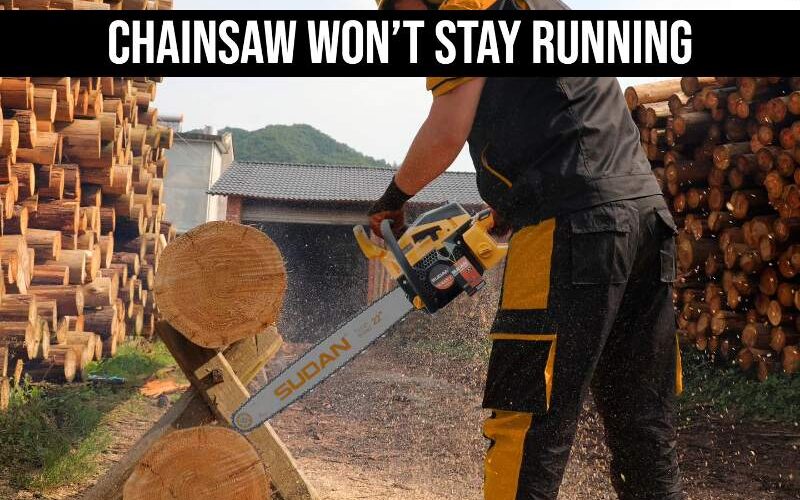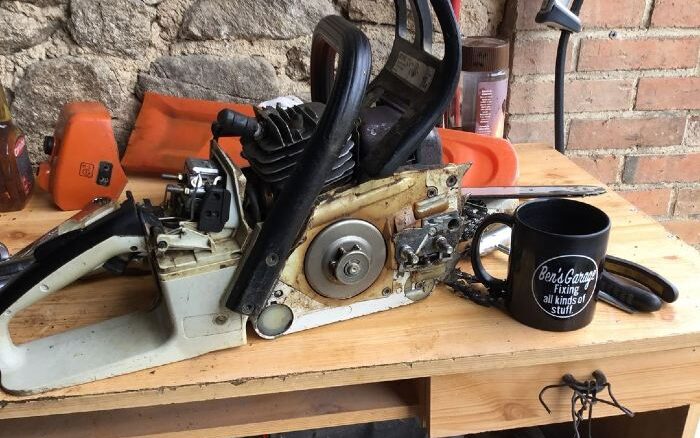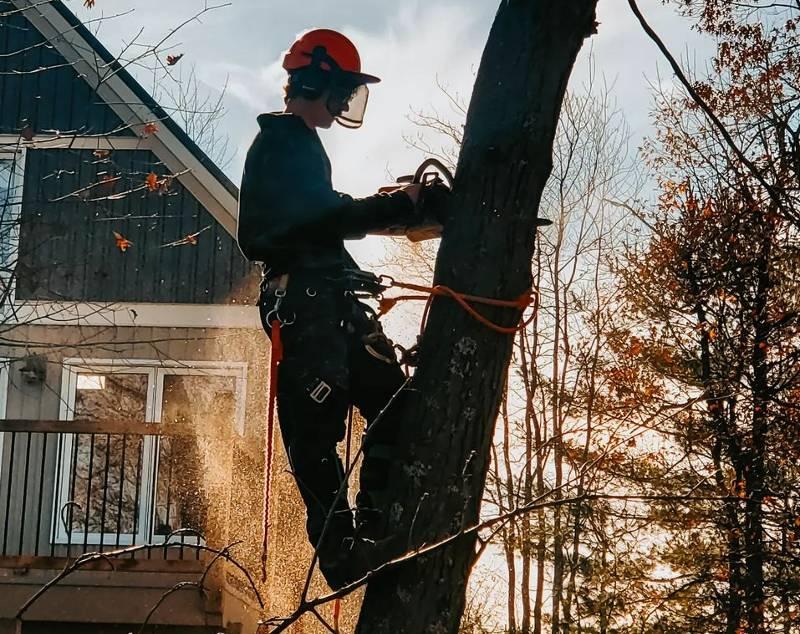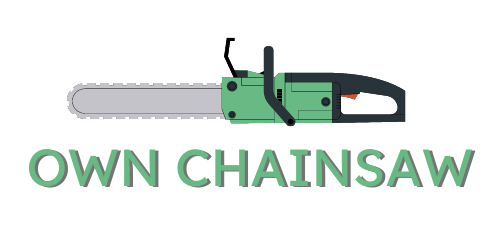
Ah, the sweet sound of a chainsaw roaring to life. There’s nothing quite like it, is there? That is until it starts sputtering, coughing, and eventually shuts off altogether.
It’s a frustrating experience that every chainsaw owner has likely experienced at one point or another: the chainsaw won’t stay running.
But fear not! Before you start racking up repair bills, there are a few things you can do to troubleshoot the problem and maybe even fix it yourself.
The good news is that most of the time, the issue is related to one of three things: air, spark, or fuel.
If your chainsaw won’t stay running, it’s likely due to a lack of one or more of these essential components. A well-functioning chainsaw can make all the difference in efficiency and safety, so keeping your saw in tip-top shape is essential.
Why My Chainsaw Won’t Stay Running? 9 Problems
There’s nothing quite as frustrating as starting up your chainsaw, only to have it stop running shortly after.
Whether you’re trying to tackle a big project or just need to quickly trim some branches, a chainsaw that won’t stay running can throw a serious wrench in your plans.
But don’t worry – this common issue can often be solved with a few simple steps. First, let’s take a look at some of the most common reasons and their solutions why your chainsaw might not be staying running:
1. Bad or failing Spark Plugs
Spark plugs are essential components in engines that produce the energy required to power your chainsaw.
The engine of a chainsaw combines a small amount of gas and oxygen in a chamber and ignites it with a spark. This combustion generates energy and moves the piston, which powers the chainsaw.
However, if the spark plug is damaged, worn out, or coated with carbon dioxide, it will not produce the necessary spark to ignite the gas and air mixture. This can lead to a chainsaw that fails to start or runs poorly.
A bad or failing spark plug can cause several issues in a chainsaw. These include difficulty starting the chainsaw, reduced power, or engine misfires.
Additionally, you may notice increased fuel consumption, unusual engine noises, or a burning smell when the spark plug is not working correctly. If left unaddressed, a damaged spark plug can even cause permanent damage to the engine.
Solution:
To fix the issue of malfunctioning spark plugs in a chainsaw, you can take some simple steps. The spark plug can be removed and cleaned first.
Any carbon buildup on the electrodes can be removed with a wire brush or spark plug cleaner. You can also replace the spark plug if cleaning doesn’t work. Using the right spark plug for your chainsaw is crucial.
You can find spark plugs that match your chainsaw model and manufacturer at most hardware stores or online.
Replacing your spark plugs regularly can also prevent issues and ensure your chainsaw runs smoothly. You can prevent engine damage by cleaning or replacing spark plugs on time.
2. Blocked Carburetor

A blocked carburetor can be a major problem for chainsaws, as it can prevent the engine from running. Providing air and fuel to the engine, the carburetor is an essential part of the chainsaw’s fuel system.
Having a blocked carburetor can lead to a range of issues that can negatively affect the chainsaw’s performance and reliability.
The main symptom of a blocked carburetor is difficulty starting the engine. The carburetor cannot supply enough fuel to the engine when it is clogged with dirt, debris, or other contaminants.
If the engine is running erratically, it may produce uneven power and stall or cut out. When cutting wood or other materials with a chainsaw, this can be dangerous.
Another problem that can arise from a blocked carburetor is reduced fuel efficiency. When the carburetor is obstructed, it can’t mix the fuel and air in the correct proportions, leading to excess fuel consumption.
You can end up wasting fuel and spending more money on your chainsaw because of this.
Solution:
To resolve this issue, the carburetor must be thoroughly cleaned. Regular retailers sell specialized cleaners that are specifically designed for cleaning carburetors.
It is important to follow the instructions on the cleaner carefully to ensure that the carburetor is cleaned properly and all obstructions are removed.
For proper cleaning, the carburetor may need to be disassembled. The carburetor should also be cleaned regularly to avoid this problem in the future.
3. Fuel Delivery Issue
A Chainsaw needs fuel to run its engine, and if there is any problem with fuel delivery, it can cause the Chainsaw to stop running.
Fuel delivery issues can arise due to various reasons, such as detached fuel lines, cracks or cuts in the fuel lines, blockages in the fuel line, and clogs in the idle port.
When the fuel lines become detached, it prevents the gas from entering the combustion chamber, and the Chainsaw won’t start.
Fuel lines can also leak gas when cracked or cut, causing the same problem. The engine can also stall if fuel cannot reach the chamber due to a blockage in the fuel line.
Solution:
Several things can be done to fix a chainsaw fuel delivery issue. First, check the fuel lines for damage or detachment. Replacing or reattaching any you find is a good idea.
In case of cracks or cuts in the fuel line, it’s best to replace the line entirely. Using compressed air or a small wire may be able to clear the blockage if the connecting component or the line itself is not damaged.
If the problem persists, check the idle port for clogs and try turning the screw to remedy the airflow issue.
4. Flooded Engine
A flooded engine is a common problem that chainsaw engines encounter, where an excessive amount of fuel enters the combustion chamber, causing the engine to fail to start or remain active.
The fuel-air mixture fails to ignite correctly, and hence the engine becomes flooded with fuel.
Over-priming the chainsaw or leaving the choke on for too long can cause this problem.
When the engine is flooded, the spark plugs become damp, and the vehicle fails to start. This is a vexing problem that can be caused by a variety of factors.
Solution:
To resolve the issue of a flooded engine, several measures can be taken. Firstly, turn off the choke and allow the chainsaw to sit still for a few minutes to allow the excess fuel to evaporate.
Once you have done this, try starting the chainsaw again. If it still won’t start, you will need to remove the spark plug and dry it off.
To do this, you can use a clean cloth or paper towel to wipe the spark plug and dry it. You can also use a cleaner for spark plugs to remove excess fuel or dirt. Once you have dried the spark plug, insert it back into the engine and give it another go.
5. Blocked Idle port
The chainsaw’s carburetor is responsible for combining gas and air within the machine. Meanwhile, the idle port serves as the crucial tube tasked with bringing air into the carburetor.
When the idle port becomes clogged or damaged, the air required to mix with the gas will not enter the carburetor, which can cause the chainsaw to stall or fail to stay running. Numerous factors can contribute to the blockage of the idle port, including debris, dirt, and other materials that obstruct the carburetor.
Solution:
To resolve this issue, you must undertake a few simple steps. First, try turning the carburetor screw to see if it enhances the airflow.
If this doesn’t help, you must thoroughly clean the idle port. To do this, remove the carburetor from the chainsaw and disassemble it.
Use a carburetor cleaner or compressed air to clean the idle port and other components of the carburetor. Inspect the idle port for dirt, debris, or fuel residues.
A damaged idle port must be replaced if it cannot be repaired. The idle port can be replaced by a professional or purchased at a hardware store or online.
6. Clogged Air Filter
Chainsaws function optimally when their engines are equipped with air filters. These filters are essential in preventing dirt, dust, and other debris from infiltrating the engine chamber.
Failure to maintain these filters may lead to reduced airflow, consequently resulting in malfunctioning chainsaws.
Without proper functioning chainsaws, professionals who rely on them for their work may face difficulties starting or running them.
Solution:
When a chainsaw’s air filter is clogged, cleaning or replacing it is the solution. The first step is to locate the filter and remove it from the chainsaw carefully.
After that, inspect it to determine the extent of clogging and debris accumulation. If the filter is only moderately dirty, washing it with warm water and soap may suffice. After cleaning, let it dry completely.
Alternatively, if the filter is very dirty or damaged, it may be necessary to replace it with a new one.
Regardless of the method chosen, ensuring that the air filter is clean and functioning properly can help restore the chainsaw to its optimal state and ensure its continued reliable performance.
7. Clogged Exhaust
A clogged exhaust results from a blocked or damaged spark arrester, which is a small screen that prevents sparks from escaping the machine. This safety feature is essential when working with combustible materials such as wood and sawdust.
As a result of the strain and speed of an aggressive chainsaw chain, it is even more important. An engine that cannot exhaust exhaust gas freely will stall and the chainsaw will not run.
Solution:
To fix the problem, it’s necessary to check if the spark arrester is clogged or damaged. The spark arrester can be removed and cleaned using a wire brush if it’s only slightly clogged.
However, if the spark arrester is too dirty or damaged, it’s better to replace it entirely.
Cleaning or replacing the spark arrester should solve the clogged exhaust problem and allow your chainsaw to continue running smoothly.
8. Damaged or Clogged Primer Bulb
The primer bulb is an essential component of the chainsaw’s fuel system. When the engine is cold, it draws fuel into the carburetor, making starting the chainsaw easier.
The chainsaw will not run if the primer bulb is damaged or clogged.
Solution:
If you suspect that a faulty or clogged primer bulb is the reason your chainsaw won’t stay running, the solution is to replace the priming bulb.
You can purchase a replacement bulb from a hardware store or online retailer. Once you have the new bulb, you will need to remove the old one and install the new one according to the manufacturer’s instructions.
9. Bad recoil Start
If your chainsaw won’t stay running, one of the possible reasons could be a bad recoil start. A chainsaw’s engine relies on the recoil starter, and when it fails to recoil onto the pulley correctly, it can cause the engine to stall.
Another common mistake that users make is placing the spring clip backward, preventing the rope from pulling.
Solution:
To fix a bad recoil start, the ideal solution is to replace the recoil starter assembly. If the starter problem is severe, a new assembly may be necessary.
When replacing the rewind springs, be sure to purchase the correct one by consulting a local hardware store. Broken starter ropes or starters that don’t recoil can be frustrating, but replacing the assembly can save a lot of time and effort.
Final Words
If your chainsaw won’t stay running, it’s not only frustrating but also dangerous. The issue could be caused by a dirty or faulty carburetor, a clogged fuel filter, a damaged spark plug, or a faulty ignition system.
It’s crucial to identify and address the root cause of the problem for the chainsaw to work properly and safely.
To avoid this problem in the future, regularly maintaining and cleaning your chainsaw, and using it responsibly is key.
Users should seek professional assistance from a qualified technician if the issue persists or if they are not comfortable performing repairs themselves.
FAQs
Can low oil cause a chainsaw to not stay running?
Yes, chainsaws can not run if the oil is low. Check the oil level and add more oil as needed.
How often should I maintain my chainsaw to prevent it from stalling?
Maintaining your chainsaw regularly can help prevent it from stalling. The air filter and fuel filter should be cleaned or replaced, the spark plug checked, and the carburetor adjusted as part of your maintenance routine. Consult the manufacturer’s instructions for maintenance intervals and procedures specific to your chainsaw model.

I am Senior Editor and CEO and I have been a chainsaw enthusiast for over 12 years. As a passionate chainsaw enthusiast, I have got a wealth of knowledge and experience with chainsaws, and I am constantly striving to expand my expertise and knowledge. Read More!
